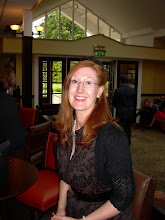 Amazingly, I'd never even seen a reproduction of the Beethoven Frieze before, but it was one of my favourite exhibits here. What caught me by surprise, though, is how much some of it looks like a kind of stylized, Art-Deco-esque Pre-Raphaelitism (feel free to argue) but look at those women on the left here - they even have red hair! Similarly, Girls with Oleanders has a wonderful medievalism that both looks back and forward, and Fable seems to me to reference Cranach's Adam and Eve - or so I wrote in my notes at the time, though looking at it again now I'm not so sure; but it does seem to refer to the Old Masters rather than contemporary painting.
Amazingly, I'd never even seen a reproduction of the Beethoven Frieze before, but it was one of my favourite exhibits here. What caught me by surprise, though, is how much some of it looks like a kind of stylized, Art-Deco-esque Pre-Raphaelitism (feel free to argue) but look at those women on the left here - they even have red hair! Similarly, Girls with Oleanders has a wonderful medievalism that both looks back and forward, and Fable seems to me to reference Cranach's Adam and Eve - or so I wrote in my notes at the time, though looking at it again now I'm not so sure; but it does seem to refer to the Old Masters rather than contemporary painting. I was taken with Klimt's landscape painting. I notice the brochure says that his landscapes are "now a highly admired aspect of his oeuvre", but to the layman (me) landscapes are not what I associate with his work. However, I loved them - busy patchworks of nature, yet the images are representative rather than natural - no Pre-Raphaelitism here! Garden Landscape with Hilltop, for example (section of it is on the right) seems almost medieval in its profusion, yet is reminiscent of Van Gogh. (As you may have noticed, I'm quite interested in aspects of influence in art as well as writing, and how an artist recreates earlier artistic ideals to his or her own ends.)
I was taken with Klimt's landscape painting. I notice the brochure says that his landscapes are "now a highly admired aspect of his oeuvre", but to the layman (me) landscapes are not what I associate with his work. However, I loved them - busy patchworks of nature, yet the images are representative rather than natural - no Pre-Raphaelitism here! Garden Landscape with Hilltop, for example (section of it is on the right) seems almost medieval in its profusion, yet is reminiscent of Van Gogh. (As you may have noticed, I'm quite interested in aspects of influence in art as well as writing, and how an artist recreates earlier artistic ideals to his or her own ends.)What I haven't got to grips with yet is Klimt's depiction of women - some are ch
 allenging, looking directly at the viewer and exuding an independent life of their own, such as the femme fatale depicted in Judith II (Salome) while others seem passive, overwhelmed by circumstance and the (male) gaze of the viewer. Of course, as the exhibition notes point out, this was a time when "Sigmund Freud's theories positing sexuality as a liberating force were highly influential, contributing to an overarching atmosphere of eroticism". True, but liberating for whom? Not many of these women look very liberated; it's the male artist who can paint them who seems to benefit here! And Ria Munk on her deathbed strikes me as a prime example of the nineteenth-century aestheticised dead woman - beautiful, but unable to talk back. Of course, it also channels Ophelia in her many guises - mad, dead, and surveyed best when silenced, apparently.
allenging, looking directly at the viewer and exuding an independent life of their own, such as the femme fatale depicted in Judith II (Salome) while others seem passive, overwhelmed by circumstance and the (male) gaze of the viewer. Of course, as the exhibition notes point out, this was a time when "Sigmund Freud's theories positing sexuality as a liberating force were highly influential, contributing to an overarching atmosphere of eroticism". True, but liberating for whom? Not many of these women look very liberated; it's the male artist who can paint them who seems to benefit here! And Ria Munk on her deathbed strikes me as a prime example of the nineteenth-century aestheticised dead woman - beautiful, but unable to talk back. Of course, it also channels Ophelia in her many guises - mad, dead, and surveyed best when silenced, apparently.











No comments:
Post a Comment